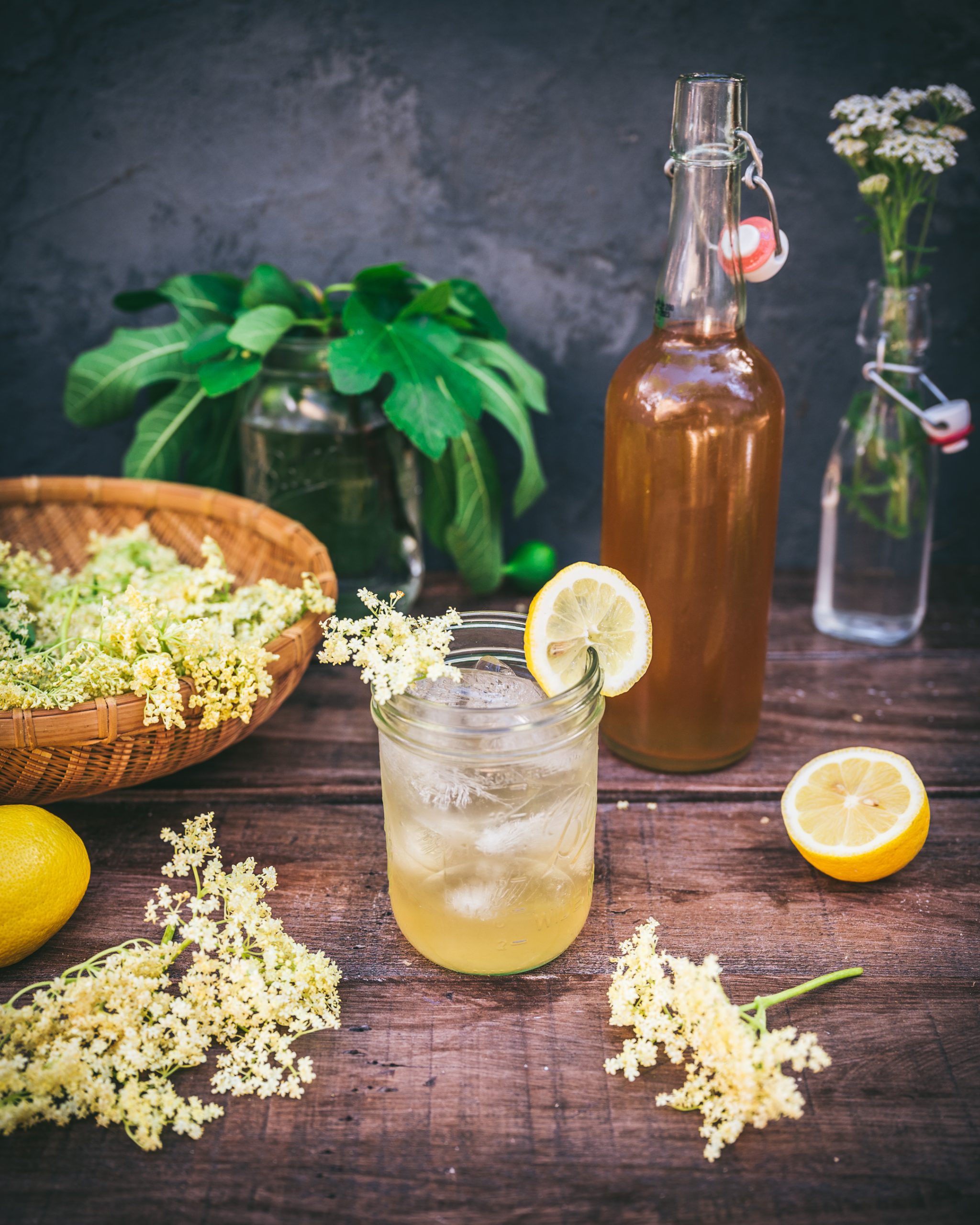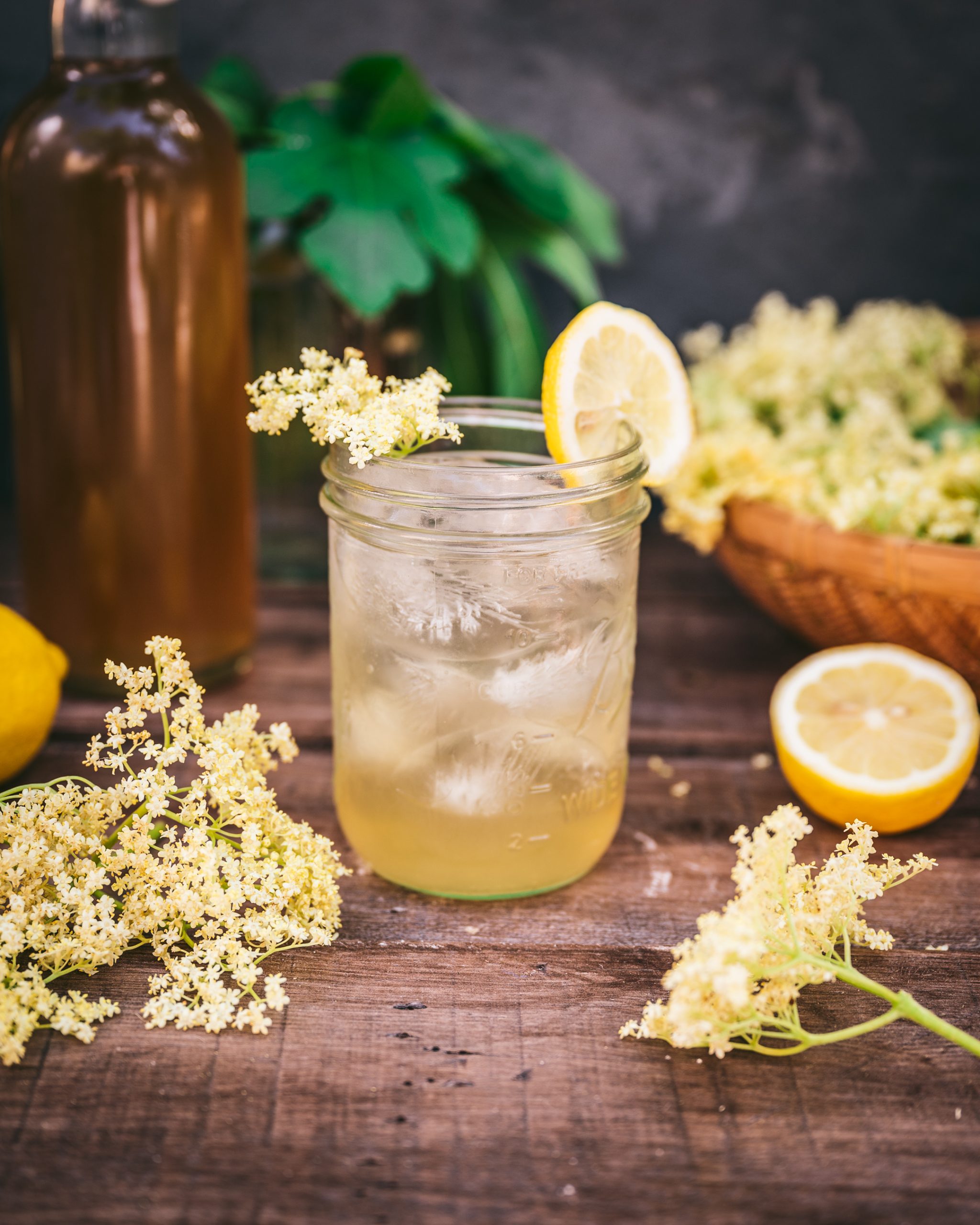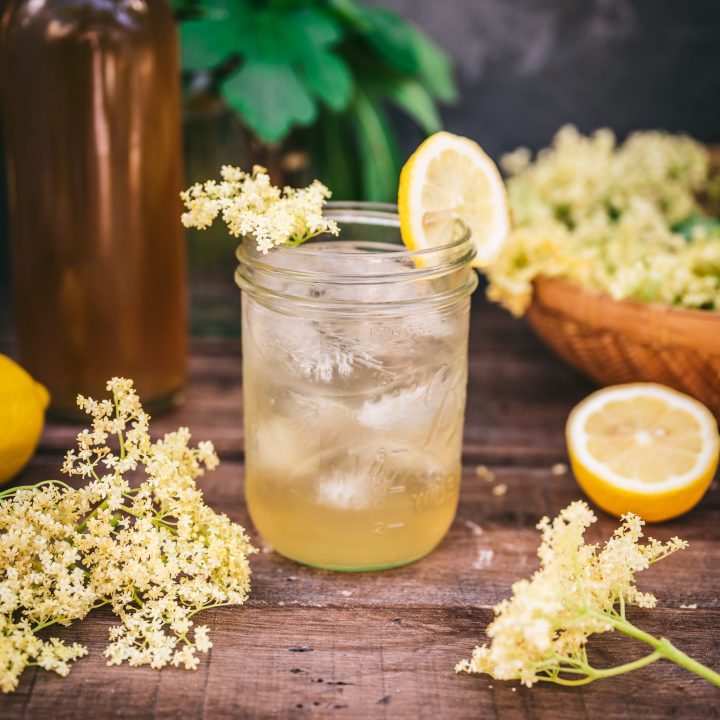This elderflower cordial is a fragrant and refreshing non-alcoholic drink. Floral, tangy, and delicious, this cordial is a wonderful way to preserve elderflowers to enjoy all year!

Every spring I make a large batch of this fragrant elderflower cordial so we can enjoy elderflowers the whole year. There is something magical about picking these sweet blossoms in spring and filling the house with their delicate fragrance.
Elderflower cordial captures the floral, blossomy scent of elderflowers and is delicious paired with sparkling water for a refreshing summery drink. It’s tangy, floral, and bursting with flavor and just a hint of sweetness.
Making your own cordial is so simple and easy! It’s a great way to preserve elderflowers and enjoy them the rest of the year. This golden elixir is the ultimate summertime drink, and is wonderful paired with wine, champagne, or prosecco for special occasions.
Harvesting Elderflowers
Elderflowers are the edible blossoms of the Elder tree, Sambucus nigra ssp. cerulea, Sambucus nigra, or Sambucus canadensis. Native to North America and Europe, the elder shrub grows abundantly near streams, rivers, and in open meadows near water.
Elderflowers bloom in early to late spring and produce blue or black berries in late summer. Elderberries are both edible and medicinal but must be cooked first to get rid of toxins.
Choose the freshest, creamy white flowers that are full of pollen to make cordial. Avoid harvesting the flowers that are starting to wilt or turn brown. If foraging on a wet day, wait to harvest the flowers until the dew has dried.

Tips for foraging elderflowers:
- Forage elderflowers 50 ft. (15 m) away from roadsides and polluted areas
- Harvest the individual flower heads that have creamy white fully opened little flowers, and before they start to turn brown or wilt
- The best time to forage elderflowers is midmorning after the dew has dried
- Choose elderflowers that smell fragrant and sweet, and watch out for any unpleasant aromas that can develop in the afternoon on a very hot day
- For the best flavor, use the flowers as soon as possible after foraging, though they can be stored in the fridge for several hours
- Elderflowers have lots of little bugs on them! The best way to remove the bugs is to give the flowers a good shake after picking, then spread the flowers on a flat surface and let them sit for an hour or so. Most of the bugs will fly away.
What Goes in Elderflower Cordial

Fresh elderfowers — you will need 20-25 large elderflower heads for this recipe. Choose flower heads that are approximately the size of your hand. If using smaller elderflowers, just double the amount.
Lemons — choose unwaxed lemons if possible, or remove the wax before using. I use locally grown organic lemons, which are unwaxed, but they have a very short shelf life! To remove wax, place lemons in a colander and pour boiling water over them. Scrub them with a brush, then rinse and dry.
Citric acid — citric acid acts as a preservative and helps extract the flavor from the elderflowers. It gives the cordial a longer shelf life (up to several months in the fridge). Use GMO free citric acid. Citric acid can be found in the canning section of most stores, or in brew shops or online.
Note: You can omit citric acid, but the cordial will have a much shorter shelf life and will lack that tang!
Sugar — I use organic cane sugar since it has a neutral taste and color.
Water — use filtered water or spring water for the best flavor. Avoid using tap water, since it can alter the taste of the cordial.
How To Make Elderflower Cordial

1. Forage 20 to 25 large elderflower heads. Choose the freshest flowers that are creamy white and full of pollen, before they begin to wilt or turn brown.

3. Wash and dry the lemons, and then slice them and add to a large pot. If the lemons are waxed, remove the wax first!

5. Place the pot on the stove, and heat over medium heat, stirring frequently until it comes to a boil. Simmer for a minute or two, then turn off the heat.

2. Pick the elderflowers from the green stems as much as possible without going crazy about it. The green stems can add bitterness to the cordial.

4. Place the elderflowers, lemons, citric acid, and water in the large pot. Don’t add the sugar at this point, it will be added later.

6. Remove from heat, and cover the pot with a lid or cloth and let it cool. Set it aside for at least 8 hours up to 48 hours. Stir it once a day.

7. Strain the cordial through a sieve lined with cheesecloth. Squeeze the cloth to extract as much of the precious liquid as possible.
8. Return the cordial to a clean pot and add the sugar. Simmer gently for five minutes, stirring frequently. This will neutralize the yeast from the elderflowers so the cordial will not ferment once you bottle it.
9. Store in sealed glass bottles in the refrigerator for up to 3 months. To enjoy elderflower cordial all year long, preserve it in glass canning jars and process in a boiling water bath for 20 minutes.

How To Use Elderflower Cordial
Elderflower cordial makes the most refreshing summer drink when mixed with sparkling water and ice. It’s very concentrated and tastes best diluted at a ratio of 1:5. For special occasions, add a splash to a glass of white wine, champagne, or summery cocktails. Drizzle over ice cream, add to sorbet, make elderflower popsicles, or anywhere than can use a burst of citrusy floral flavor.

Elderflower Cordial
This elderflower cordial is a fragrant and refreshing non-alcoholic drink. Floral, tangy, and delicious, this cordial is a wonderful way to preserve elderflowers to enjoy all year!
Ingredients
- 20-25 large elderflower heads (use double if small)
- 2 lemons, sliced
- ¼ cup (50 g) citric acid
- 2 ½ liters (85 oz) water
- 5 cups (1 kg) cane sugar
Instructions
- Forage fresh elderflowers, and set them on a flat surface for an hour to let the little insects escape. Don't wash the flowers!
- Pick the elderflowers from the green stems as much as possible. The green stems are bitter.
- Add the elderflowers, lemons, citric acid, and water to a large pot. Don't add the sugar yet.
- Bring to a boil and simmer for 15 minutes. Remove from heat, cover the pot, and let it cool.
- Set aside for at least 8 hours up to 48 hours. Stir once a day.
- Strain the cordial through a sieve lined with cheesecloth. Squeeze the cloth the extract every drop of delicious liquid possible.
- Return the cordial to a pot and add the sugar. Bring to a boil, stirring frequently to dissolve the sugar. Simmer gently for 5 minutes to neutralize the yeast. This prevents the cordial from fermenting once bottled.
- Sanitize glass bottles by placing in boiling water. Sanitize the funnel as well.
- Bottle the cordial in glass bottles, and store in the refrigerator for up to 3 months.
Notes
To enjoy elderflower cordial all year long, preserve it in glass jars and process it in a boiling water bath. I process them for 20 minutes and store them in a cool dark place. Refrigerate after opening.
Elderflower cordial is meant to be diluted 1:5 before enjoying.
No Comments